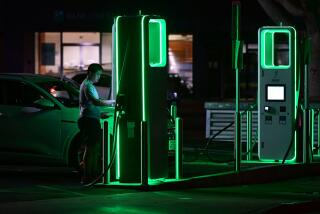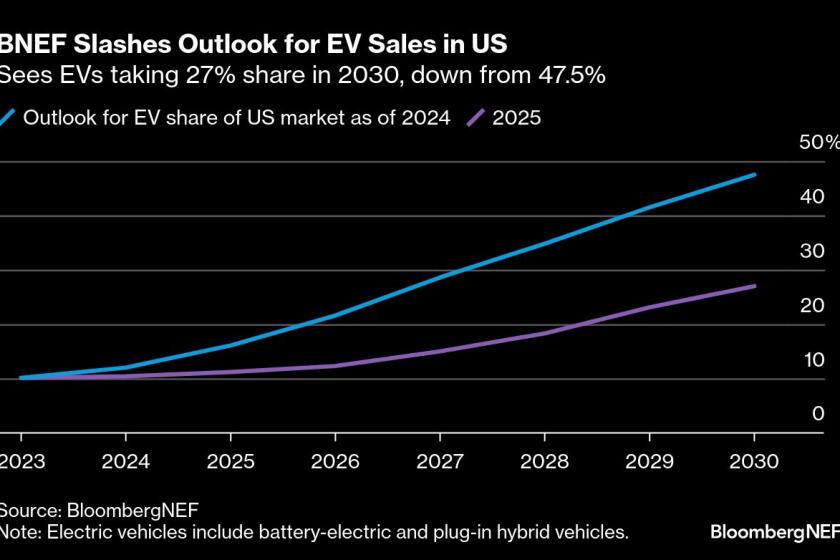Higher-Voltage Cars Could Jolt the Wallet Too
- Share via
Electrical fires, battery explosions, shocks and costlier mechanical repairs are among the issues you might find interesting in connection with the higher-voltage electrical systems being planned for future vehicles.
The auto industry wants to assure you that you have nothing to worry about. Nonetheless, a lot of the bad things that occur with passenger vehicles involve poorly behaved electricity. And the plan for higher voltage will give cars and trucks a decidedly bigger electrical punch.
An elite group of automotive engineers and academicians led by the Massachusetts Institute of Technology is now laying the groundwork for tripling the voltage that has been the standard for passenger vehicles since before Hawaii and Alaska became states.
Most motorists are probably unaware that their cars and trucks run on a 12-volt electrical setup, consisting of a wiring harness and control system that is more sophisticated than what’s in their house. But the existing system can’t provide the power for the coming revolution in auto technology, and the plan is to hike the voltage to 36 volts.
(As a technical side note, the actual voltage of current systems is 14 volts, because that’s the power output from the alternator needed to keep the 12-volt battery charged. Future vehicles will have 42-volt systems to keep a 36-volt battery charged.)
Much of the hype about these higher-voltage systems centers on cell phones, Internet connections and navigation devices that are going to exceed the capacity of 12-volt systems. But such uses are a minor consideration, said Thomas A. Keim, an MIT research engineer and co-director of the consortium his university leads.
The real driver of these higher-voltage systems is a revolutionary plan to electrify many of the key mechanical functions of passenger vehicles that are now operated with belts and shafts under the hood: water pumps, engine valves, steering systems, active suspension, brakes and even air conditioning.
In a few years, cars and trucks are expected to have 3,000- to 7,000-watt electrical systems--or about two to five times the steady power used by current large luxury cars--supplied by a generator running off the engine crankshaft. That’s about what a typical small house uses.
So why should you care? The upside of these systems is that vehicles will be lighter and more efficient than ever. Current belt-driven pumps and compressors waste lots of energy. They’ll be replaced by water pumps, for example, that will turn on only when needed, Keim said.
One big dream of engineers is to allow engines to shut off completely during idle and then start up again instantly with a touch of the accelerator pedal, Keim said. How? Electrically operated valves would allow an engine to start without cranking.
The downside is something we don’t know much about, but it’s worth discussing. Take, for example, electrical fires. Every day, radio stations report freeway jams caused by burning vehicles. Why do all those cars and trucks catch fire? In many cases, it is because of electrical problems.
In other words, after decades of experience in design and manufacturing, auto makers still can’t build a foolproof 12-volt system. In 1996, for example, Ford Motor Co. recalled 8.33 million vehicles with defective ignition switches that were blamed for about 2,000 fires.
Higher-voltage electrical systems will inevitably heighten the potential for automotive electrical fires. Elliott R. Brown, a UCLA professor of electrical engineering, says that many such fires are caused by insulation failures. Higher voltages will require even more challenging types of insulation.
What about electrical shocks? Auto mechanics are worried about the potential for shock when they hear about the 42-volt system.
The researchers at MIT say there is no need to worry. Keim noted that the consortium chose 42 volts because it is the highest voltage that would not endanger humans. Indeed, telephone systems often use similar voltages.
But future cars will be putting out a lot more amperage than telephone wires typically carry, says Michael S. Morse, an electrical shock expert, lawyer and electrical engineering professor at the University of San Diego.
Morse doubts that 42-volt systems could cause injury, much less death, to the vast majority of people. In most cases, even a 110-volt shock from a household outlet does not cause injury. But he says it won’t be too long after these new systems appear that a smattering of liability suits will arise involving the small minority of people who are highly susceptible to electrical shock.
Shock damages tissue in many ways: interrupting the heartbeat, burning tissue and causing muscle contraction. Morse said more research needs to be done on voltage shocks involving direct current, the kind used in cars.
UCLA’s Brown, for his part, says he would feel uncomfortable working around a 42-volt auto system, particularly if he had sweaty hands, which of course many mechanics do when they’re at work.
Finally, there’s the issue of battery explosions. More than 2,000 people require hospital treatment each year from car battery explosions that spray out concentrated acid. Will the new, higher-voltage systems raise that risk? Auto makers are considering designs that prevent jump-starting a dead battery, a leading cause of explosions.
But that isn’t going to be a hit with low-income motorists. Indeed, you can bet that these new electrical systems are not going to be cheap to fix. Electrical repairs are quickly becoming the bane of motorists. Sensors, control modules and alternators all can cost many hundreds of dollars.
As the new systems are introduced, auto makers are planning to run dual electrical systems so that part of the vehicle will run at 14 volts and part at 42 volts. That will help lightbulb, motor and component manufacturers cope with the conversion.
I have a hunch that tripling voltage will really mean tripling the cost of at least some types of future auto repairs.
*
Ralph Vartabedian can be reached at ralph.vartabedian@latimes.com.







